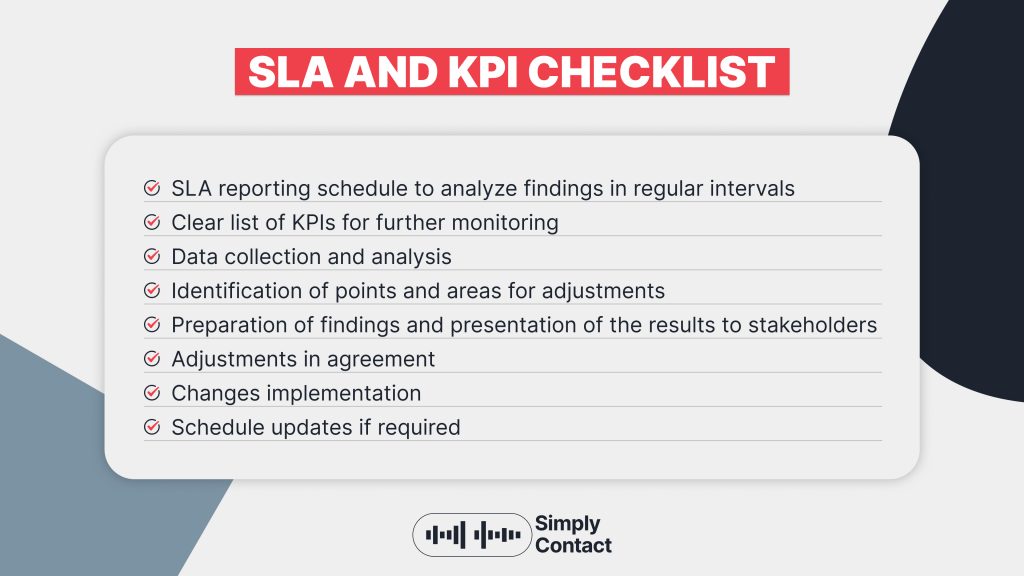At Simply Contact, we specialize in creating personalized customer support solutions that drive business growth and customer satisfaction. Let us help you elevate your customer experience and stand out from the competition.

SLA vs KPI: What’s the Difference and Why Both Matter in Customer Support
Key performance indicators (KPI) and service level agreements (SLA) are common terms used during customer support performance discussions. Metrics help support teams to evaluate the current state of customer satisfaction and achieved goals. Using indicators as a guiding star, experts can adjust the company’s strategy and define the direction of further improvements.
A clear understanding of metrics and referring to them is the key to effective performance monitoring. This is why we devote this article to the difference between SLA and KPI. We will explain both terms and share an expert insight into their importance for customer support services. Here you can find a real case where agreement and indicators made the difference. Alongside explanations and examples, we will also review common mistakes companies often make when working with indicators and add a simple checklist for support teams.
What are SLA and KPI in simple words?
An SLA (Service Level Agreement) is a contract between a company and its clients or vendors. This agreement describes the services a partner can expect and what they will receive in the process. It is a simple and effective way to document expectations and note the main goals of collaboration. You can consider SLA as the minimum acceptable standard for services.
KPIs (Key Performance Indicators) are metrics that measure how well a company aligns with its set strategic goals and detect the weak points for further adjustment and improvement. Chosen KPIs typically depend on the industry in which the company operates and the specific target of the related project.
KPI vs SLA: Key differences and how they work together
KPI is a solution that enables internal performance measurement and monitoring, while SLA mostly describes service commitments. If an agreement outlines the obligations between partners, the KPI indicates how well the service provider aligns with the desired goals.

Expert insight: Why you need both KPIs and SLAs in customer support
At Simply Contact, we believe that only together can these tools have the maximum impact on customer service teams’ performance. Concluding an SLA, businesses can discuss and set clear expectations that both parties understand and agree upon. Using KPIs, meanwhile, customer support can ensure that you work in compliance with agreed terms and goals.
For example, according to SLA, a customer support team should respond to 90% of tickets within an hour. The KPI can measure actual performance and indicate whether the goal has been reached or if agents need to push harder.
You can also calculate SLA’s score to see how close you are to the desired results with the help of this formula:
Number of processed calls or tickets / total number of calls or tickets x 100
As a result, you will receive the percentage of successfully processed cases and see how far you are from the prescribed numbers.
It is only one example of metrics an SLA may contain, while businesses can develop much longer lists depending on their services. For instance, customer service providers often refer to the following KPIs in SLAs:
- First response time
- Customer satisfaction score
- Net promoter score
- First contact resolution
- Average resolution time
- and a bunch of others
At Simply Contact, we measure and track KPIs while prioritizing service level agreements. Work with an outsourcing team that knows how to make it right.
Book a consultation
SLAs and KPIs: Real case
The best way to see the impact of these tools on results is to review a real case. Here is what Simply Contact faced as an outsourcing customer support service provider, and what we achieved working with accurate KPI monitoring.
Fareportal is a US company related to travel technology. Its services are connected to over a million hotels, hundreds of airlines, and car agencies.
To prepare an agreement, we set goals such as increasing customer retention and raising customer satisfaction from 0%, caused by the absence of monitoring, to a decent level for such a huge company.
Thanks to constant KPI monitoring, we managed to achieve a 15-18% retention rate among clients and increased customer satisfaction to 75%. We have processed over 20,000 calls per month and increased the Net Promoter Score to 56%.
This case demonstrates how set standards can guide workflows and how KPIs help evaluate the progress via real and measurable metrics. Monitoring and control allow us to optimize processes by scaling teams and improving service quality.
Common mistakes companies make when working with KPI and SLA
In our experience, companies that are just starting to work with service level agreements and key performance indicators make mistakes that impact the whole process. So, to avoid such an unpleasant situation, we have prepared a short guide on the most widespread issues.
Unclear goals
Sometimes, business owners state just “quick issue resolution” and fail to specify the exact time frames or priority of critical cases. If team members are uncertain about instructions and a clear definition of this so-called “quick resolution,” they may fail to match the goal. If you note clear and realistic metrics you want to see during the collaboration, the service provider will be more likely to achieve the required result and avoid confusion among agents.
Lack of solutions for process automation
Automation can make monitoring more accurate and simpler for management. AI-powered monitoring systems can analyze a larger volume of processed cases and create reports for further evaluation and process adjustments. If you also implement the system for escalation situations, it will also reduce response time and potential issues with overdue cases. For instance, smart ticket sourcing can mark critical cases and route them to suitable teams or agents.
Incorrect metric choice
Sometimes, new businesses prefer to use metrics that are easier to collect and evaluate. However, we recommend not just measuring everything easy to check but sticking to the metrics that are relevant and important, specifically to your industry and business goals. Another side of incorrect choice is an attempt to measure everything possible and impossible, ignoring the fact that not all KPIs have the same value for different industries. For example, nearly half of businesses are not completely sure if they use the correct metrics. Working with experts can fix this problem by choosing the right one based on specific business needs.
Measurements without further actions
When you detect weak points in your workflows, it is important to find a solution for how to fix the issue, not just indicate it. The best you can do with gaining insights is to develop a strategy for upgrading the process and improving results. It may include the use of more efficient tools, process optimization, team scaling, or extra training for agents.
SLA and KPI checklist for your support team

Conclusions
Understanding the difference between KPI and SLA, you can develop an efficient process of SLA creation and further KPI monitoring. In our experience, both tools are essential for effective team operation, as service level agreements set clear goals for the agents. At the same time, key performance indicators help ensure they hit the target. As a result, both of them enable productive guidance throughout the process and signal where the initial plan requires prompt changes and valuable improvements.
Get fast answers to any remaining questions
Thank you.
Your request has been sent successfully.
Your request has been sent successfully.



